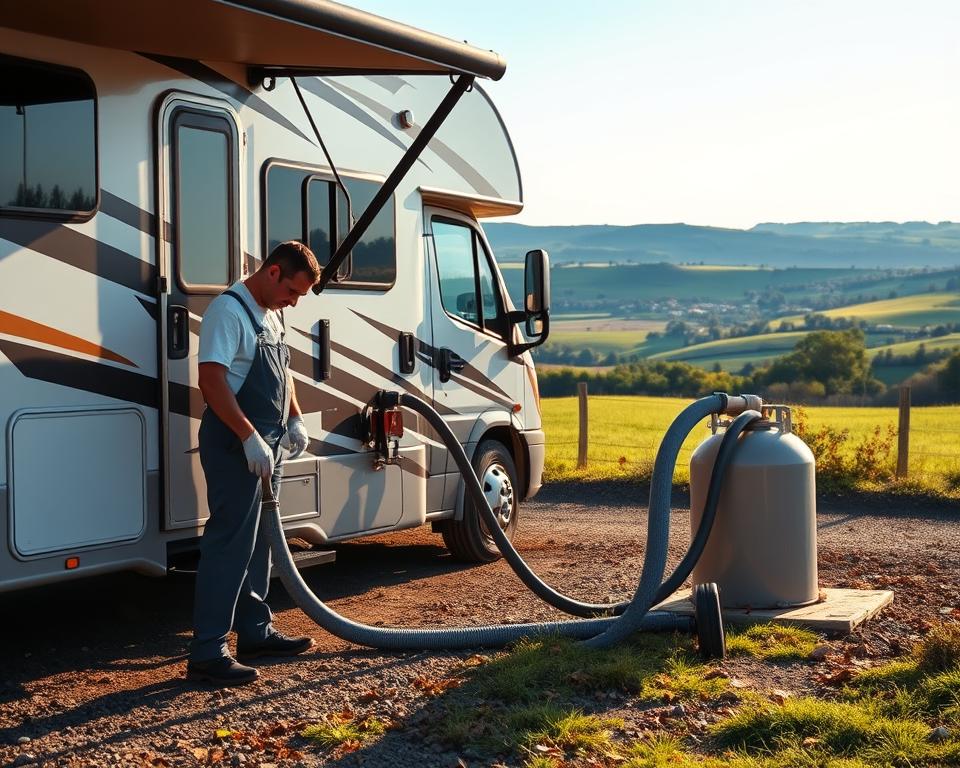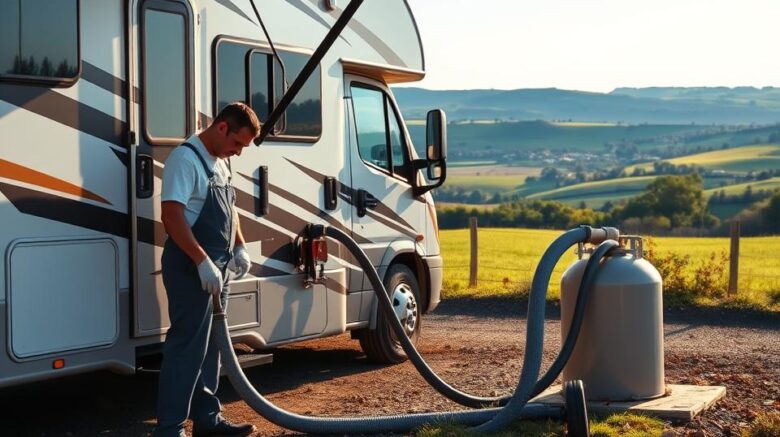RV Waste Pump Guide: Efficient Disposal Solutions
Have you ever considered how vital proper waste disposal is while journeying in your recreational vehicle? A lot of travelers notice waste handling dulls their excitement. The effort to find a suitable dumping station and the complications of black-water tank care can interfere with your outdoor adventure. Yet, a stalwart RV waste pump provides the efficiency you need for smooth waste disposal. This guide showcases the importance of RV sewage pumps in upgrading disposal routines. It secures spotlessness, improving your RV journey.
Main Points
- Efficient sewage handling is indispensable for RV owners.
- Trustworthy macerator units can improve waste disposal processes.
- On-the-go pump systems boost flexibility during camping trips.
- Grasping wastewater tank care is key for RV sanitation.
- Effective removal strategies upgrade overall camping experiences.
Getting to Know RV Waste Systems
Preserving cleanliness and comfort on the road calls for organized waste disposal. A good setup includes a toilet sewage tank for human waste. It also comprises other elements crucial for sanitation. Understanding these parts is vital for safe and hassle-free waste disposal.
The waste from RVs differs from household wastewater. This fact highlights the importance of dedicated sewage handling. Trippers need to learn on caring for their sewage reservoir. Proper care wards off odors and clogs, which can impede your trip.
Locating dump sites is key, especially in off-grid locations. While many campgrounds offer dumpsites, they aren’t always accessible. Thus, preparing in advance is beneficial. This planning can significantly improve your camping experience.
In essence, performing RV sewage disposal efficiently requires knowing your RV’s waste system and planning for sanitation. Being aware provides a more enjoyable outing in your RV.
What is an RV Waste Pump?
A motorhome disposal pump is essential for disposing sewage from RVs. The RV macerator pump chops solid waste into fine mixture. This permits smooth flow through a discharge hose to a disposal site. It’s especially useful when height prevents gravity dumping.
Basic camper pumps and RV macerator pumps contrast in operation. Macerator pumps shred waste, making disposal simpler. This simplifies dumping in remote areas.
All users need to grasp how an RV waste pump behaves. Using a grinder unit improves waste management, also facilitates removal in remote areas. Proper use maintains system performance, enhancing your RV adventures.
Mechanics of a Macerator Pump
An RV macerator pump employs premium cutting elements that grind waste into a smooth sludge, like a food waste macerator. This efficiency is essential for disposal in RVs. By converting solid waste, the pump allows sewage to be pushed through lengthy hoses. It also assists in transporting uphill, reducing clog risks.
Each time the toilet is flushed, the grinder blades are activated. This self-starting mechanism ensures a smooth waste processing. It simplifies the disposal process, especially when emptying into septic tanks. Thus, RV owners are assured of a reliable and safe waste handling system.

Benefits of Using an RV Waste Pump
An RV waste pump offers substantial benefits in efficient waste disposal, transforming waste management for RV enthusiasts. A major perk is the enhancement of sanitary conditions. This device streamlines dumping, substantially minimizing contamination risks.
Having a macerator pump means handling disposal easily, even in remote areas. This gets rid of the need for traditional, bulky disposal methods. The ease it offers guarantees peace of mind while traveling. It grants easy access to sewer connections or portable dump stations, stationary or in motion.
Moreover, these pumps are crafted to fight smells. Many include odor-sealing mechanisms. This creates a smell-free environment inside your RV, making travels nicer.
Their space-saving design means they don’t take up much room, preserving valuable space for other essentials. Opting for an RV waste pump is a wise decision for upgrading your camping lifestyle.
Where Camper Pumps Excel
Camper sewage grinders are not limited to RVs. They are vital for proper sewage handling in various scenarios. This includes boats, compact dwellings, and even construction sites. They meet varied tasks, suited to lifestyles and disposal requirements.
For those boondocking, RV waste pumps are game-changers. They simplify on-site dumping. Enthusiasts can then embrace camping, free from hygiene worries. It’s a must-have for anyone committed to RV camping.
In the tiny homes community, these pumps are game-changers. Room is scarce, and maintaining hygiene is paramount. RV waste pumps cover both, managing waste without using excessive space. They slot effortlessly into tight quarters.
Project zones see a lot of waste. RV waste pumps deliver aid to this problem. They prevent mess, and align with health regulations. Their capacity for robust dumping makes them irreplaceable for construction projects.
Their flexibility underscores their importance in efficient handling. They are crucial in many environments, from RVs and tiny homes to construction sites. Their reliability in upgrading disposal is peerless.
Selecting the Ideal Camper Pump
Selecting an appropriate camper sewage unit involves several critical elements. Analyzing the pump’s capacity, durability, and fit for your RV’s size is crucial. It’s imperative to pick a pump that can withstand how often you’ll use it.
Major elements to analyze are:
- Frequency of use: Evaluate how often you’ll need the pump to handle effluent adequately.
- Route type: Think about the types of campsites you’ll encounter. Some pumps manage elevation changes with ease.
- Ease of installation: Look for models that are simple to fit, so you can begin operation without delay.
- Waste management requirements: Identify the sewage composition you’ll be pumping to confirm pump compatibility.
Take care in analyzing these elements. This provides you make a sound decision. Selecting the ideal RV waste pump will considerably improve your RV experience.
Popular RV Waste Pumps on the Market
Selecting a top RV waste pump can markedly better your RV lifestyle. Top picks include the Shurflo Macerator 8000. They boast functions that address varied needs within the RV community.
The SewerFlo Quick Release is praised for its quick operation and easy operation. It delivers a powerful suction that efficiently purges reservoirs. Its dependability and small size make it a favorite for those valuing speed.
The Flojet 18555-000A stands out among sewage shredders. It is built for versatility, managing diverse effluent types with ease. Its robust framework and convenient functions render it essential for heavy-duty applications and functionality enthusiasts.
| Feature | SewerFlo Quick Release | Flojet 18555-000A |
|---|---|---|
| Flow Rate | 30 GPM | 13 GPM |
| Weight | 8 lbs | 6 lbs |
| Portability | High | Medium |
| Durability | Moderate | High |
Consumer opinions on models spotlight their special features that influence buying decisions. Simplicity and efficiency are key, directing users in their selections. Whether it’s the SewerFlo, understanding their differences guarantees you find the best waste pump.
Installation and Maintenance Tips for Your RV Waste Pump
Securing correct fit of your RV waste pump is crucial. It creates a secure connection to the RV’s waste system, ensuring no leaks and guaranteeing peak performance. Start by selecting an best area near the waste tank. This reduces tube distance, positively impacting efficiency. Secure the pump firmly, following the manufacturer’s guidelines for peak reliability.
To install your RV waste pump effectively, follow these guidelines:
- Assemble required parts and tools.
- Before starting, shut down the system and drain the reservoir.
- Position the pump in an ventilated, accessible area.
- Attach the discharge hose to the pump and route it to the dump site.
- Tighten all fittings before starting the pump.
Effective upkeep significantly lengthens your pump’s lifespan. Here are key upkeep practices:
- Monthly, inspect the pump and hoses.
- Employ recommended cleaning agents to prevent blockages.
- Run the pump periodically when not in use to keep gaskets supple.
- Ensure surrounding area is clean.
Should you run into snags like weak suction, try these troubleshooting steps:
- Inspect the discharge hose for clogs.
- Confirm electrical supply and seals.
- Consult the owner’s manual for model-specific fixes.
Other Options for Camper Waste Management
RV owners need to handle sewage properly for a pleasant trip. Fixed disposal points are often unavailable in remote spots. Thus, considering other options is essential. A mobile RV pumping service allows on-site tank emptying, saving you time.
Other options include dry toilets and carry-along tanks. Composting toilets require little moisture and convert waste into compost. Portable containers offer simple waste hauling as needed.
Choosing appropriately depends on personal preference. By evaluating these options, RVers can ensure cleanliness while exploring.
The Bottom Line
Proper camper sewage handling is vital for a clean RV interior on the move. We’ve covered various waste pumps, their functions, and advantages. A good macerator enhances travel by ensuring smooth emptying.
Choosing a pump from All in Sanitation simplifies disposal and fosters carefree travel. With suitable tools, RVers can travel worry-free, without dumping hassles, creating a better experience for all.
Maintaining cleanliness underscores the need for proper waste handling, enhancing travel experiences and guaranteeing a pleasant journey.
